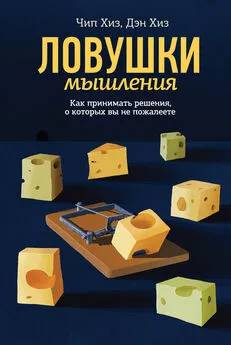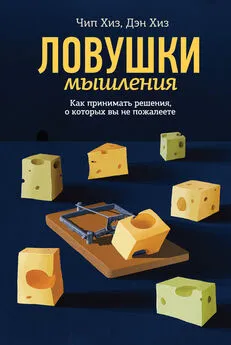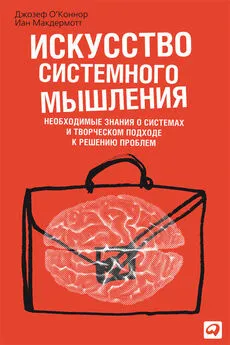Джозеф Халлинан - Почему мы ошибаемся. Ловушки мышления в действии
- Название:Почему мы ошибаемся. Ловушки мышления в действии
- Автор:
- Жанр:
- Издательство:Манн Иванов Фербер
- Год:2014
- Город:Москва
- ISBN:978-5-00057-211-5
- Рейтинг:
- Избранное:Добавить в избранное
-
Отзывы:
-
Ваша оценка:
Джозеф Халлинан - Почему мы ошибаемся. Ловушки мышления в действии краткое содержание
На русском языке публикуется впервые.
Почему мы ошибаемся. Ловушки мышления в действии - читать онлайн бесплатно ознакомительный отрывок
Интервал:
Закладка:
Jones G. V., 1990, Misremembering a Common Object: When Left Is Not Right, Memory & Cognition 18 (2), pp. 174–182.
Kahneman D., et al., 2004, A Survey Method for Characterizing Daily Life Experience: The Day Reconstruction Method, Science 306, pp. 1776–1780.
Kahneman D., 2006, Would You Be Happier If You Were Richer? A Focusing Illusion, Science 312, pp. 1908–10.
Kahneman D., and W. Scott Peavler, 1969, Incentive Effects and Pupillary Changes in Association Learning, Journal of Experimental Psychology 79, pp. 312–118.
Kahneman D., and A. Tversky, 1973, On the Psychology of Prediction, Psychological Review 80 (4), pp. 237–251.
Kahneman D., and A. Tversky, 1979, Prospect Theory: An Analysis of Decision Under Risk, Econometrica 47 (2), pp. 363–391.
Kendall P., 1994, PINS Pile Up Until They Become Personal Pain, Chicago Tribune, Oct. 14, p. C1.
Keren G., 1987, Facing Uncertainty in the Game of Bridge: A Calibration Study, Organizational Behavior and Human Decision Making 39, pp. 98–114.
Keysar B., and A. S. Henley, 2002, Speakers’ Overestimation of Their Effectiveness, Psychological Science 13 (3), pp. 207–212.
Kiley D., and E. Eldridge, 2002, Are Those Gizmos on the Dashboard Too Distracting? USA Today, May 29.
Killion A., 2007, author interview.
King G. F., 1986, Driver Performance in Highway Navigation Tasks, Transportation Research Record 1093, pp. 1–11.
Klauer S. G., 2007, author interview.
Klauer S. G., et al., 2006, The Impact of Driver Inattention on Near-Crash/Crash Risk: An Analysis Using the 100-Car Naturalistic Driving Study, National Highway Traffic Safety Administration, Report No. DOT HS 810 594, Washington, D.C.
Klein S., 2007, The Secret Pulse of Time, New York: Marlowe.
Klein W. M., and Ziva Kunda, 1993, Maintaining Self-Serving Social Comparisons: Biased Reconstruction of One’s Past Behaviors, Personality and Social Psychology Bulletin 19, pp. 732–739.
Kluger J., 2006, Why We Worry About the Things We Shouldn’t… and Ignore the Things We Should, Time, Dec. 4, pp. 64–71.
Konigsberg E., 2008, City Council Bill Would Ban Text Messaging While Driving, New York Times, Aug. 15, p. A16.
Kruger J., 2007, Author interview.
Kruger J., D. Wirtz, and D. T. Miller, 2005, Counterfactual Thinking and the First Instinct Fallacy, Journal of Personality and Social Psychology 88, pp. 725–735.
Kubovy M., 1977, Response Availability and the Apparent Spontaneity of Numerical Choices, Journal of Experimental Psychology: Human Perception and Performance 3 (2), pp. 359–364.
Kubovy M., and J. Psotka, 1976, The Predominance of Seven and the Apparent Spontaneity of Numerical Choices, Journal of Experimental Psychology: Human Perception and Performance 2 (2), pp. 291–294.
Kuebli J., and R. Fivush, 1992, Gender Differences in Parent-Child Conversations About Past Emotions, Sex Roles 27 (11/12), pp. 683–698.
Lambert C., 2006, The Marketplace of Perceptions: Behavioral Economics Explains Why We Procrastinate, Buy, Borrow, and Grab Chocolate on the Spur of the Moment, Harvard Magazine, March – April, p. 50.
Landro L., 2008, Hospitals Tackle High-Risk Drugs to Reduce Errors, Wall Street Journal, March 5, p. D1.
Landy D., and H. Sigall, 1974, Beauty Is Talent: Task Evaluation as a Function of the Performer’s Physical Attractiveness, Journal of Personality and Social Psychology 29 (3), pp. 299–304.
Langer E., 1975, The Illusion of Control, Journal of Personality and Social Psychology 32 (2), pp. 311–328.
Langer E., and J. Roth, 1975, Heads I Win, Tails It’s Chance: The Illusion of Control as a Function of the Sequence of Outcomes in a Purely Chance Task, Journal of Personality and Social Psychology 32 (6), pp. 951–955.
Lawton C. A., 1994, Gender Differences in Way-Finding Strategies: Relationship to Spatial Ability and Spatial Anxiety, Sex Roles 30 (11/12), pp. 765–779.
Lawton C. A., 2001, Gender and Regional Differences in Spatial Referents Used in Direction Giving, Sex Roles 44 (5/6), pp. 321–337.
Lawton C. A., and J. Kallai, 2002, Gender Differences in Wayfinding Strategies and Anxieties About Wayfinding: A Cross-Cultural Comparison, Sex Roles 47 (9/10), pp. 389–401.
Leibovich M., 2004, George Tenet’s «Slam-Dunk» into the History Books, Washington Post, June 4, p. C1.
Leonhardt D., 2006, Why Doctors So Often Get It Wrong, New York Times, Feb. 22, p. C1.
Levin A., and B. Heath., 2007, Fatigue Key to Air Crew Errors, USA Today, Nov. 8, p. 1.
Levin D. T., and D. J. Simons, 1997, Failure to Detect Changes to Attended Objects in Motion Pictures, Psychonomic Bulletin & Review 4 (4), pp. 501–506.
Lichtenstein S., and B. Fischhoff, 1977, Do Those Who Know More Also Know More About How Much They Know? Organizational Behavior and Human Performance 20, pp. 159–183.
Lichtenstein S., B. Fischhoff, and Lawrence D. Phillips, 1982.
Calibration of Probabilities: The State of the Art to 1980, In Judgment Under Uncertainty, edited by D. Kahneman, et al., Cambridge, U.K.: Cambridge University Press.
Linderman L., 1979, Playboy Interview: Burt Reynolds, Playboy 26 (10), pp. 67–94.
Lobben A. K., 2004, Tasks, Strategies, and Cognitive Processes Associated with Navigational Map Reading: A Review Perspective, Professional Geographer 56 (2), pp. 270–281.
Loewenstein G., 2007, Author interview.
Loewenstein G., and D. Schkade, 1999, Wouldn’t It Be Nice?
Predicting Future Feelings, In Well-Being: The Foundations of Hedonic Psychology, edited by Daniel Kahneman, Ed Diener, and Norbert Schwarz. New York: Russell Sage Foundation.
Loftus E., et al., 1987, Time Went By So Slowly: Overestimation of Event Duration by Males and Females, Applied Cognitive Psychology 1, pp. 3–13.
Lohr S., 2007, Slow Down, Brave Multitasker, and Don’t Read This in Traffic, New York Times, March 25.
Loomis J. M., Roberta L. Klatzky, R. G. Golledge, and J. W. Philbeck, 1999, Human Navigation by Path Integration, In Wayfinding Behavior: Cognitive Mapping and Other Spatial Processes, edited by Reginald G. Golledge, Baltimore: Johns Hopkins University Press.
Lord A. B., 1960, The Singer of Tales, Cambridge, Mass.: Harvard University Press.
Lorentz G. B. A., et al., 1999, Miss Rate of Lung Cancer on the Chest Radiograph in Clinical Practice, Chest 115, pp. 720–724.
Luchins A. S., 1942, Mechanization in Problem Solving, Psychological Monograms 54 (248), pp. 1–95.
Luchins A. S., and E. H. Luchins, 1950, New Experimental Attempts at Preventing Mechanization in Problem Solving, Journal of General Psychology 42, pp. 279–297.
Lundberg G. D., 1998, Low-Tech Autopsies in the Era of High-Tech Medicine, JAMA 280 (14), pp. 1273–1274.
Lykken D., and A. Tellegen, 1996, Happiness Is a Stochastic Phenomenon, Psychological Science 7 (3), pp. 186–189.
Maccoby E. Emmons, and Carol Nagy Jacklin, 1974, The Psychology of Sex Differences, Stanford, Calif.: Stanford University Press.
Mack A., and I. Rock, 1998, Inattentional Blindness, Cambridge, Mass.: MIT Press.
Macur J., 2007, Rule Jostles Runners Who Race to Their Own Tune, New York Times, Nov. 1, p. 1.
Malmendier U., and G. Tate, 2005, CEO Overconfidence and Corporate Investment, Journal of Finance 60 (6), pp. 2661–2700.
Manhart K., 2004, The Limits of Multitasking, Scientific American Mind, Dec.
Marcus E. N., 2006, When Young Doctors Strut Too Much of Their Stuff, New York Times, Nov. 21.
Martin M., and Jones, G., 1999, Hale-Bopp and Handedness: Individual Differences in Memory for Orientation, Psychological Science 10 (3), pp. 267–269.
Martinez-Conde S., and Macknik S. L., 2007, Windows on the Mind, Scientific American, Aug., pp. 56–63.
Mateja J., 2007, S80 Makes Big Impression in a Flash, Chicago Tribune, March 25.
Mathews C. O., 1929, Erroneous First Impressions on Objective Tests, Journal of Educational Psychology 20, pp. 280–286.
Mathur P., and J. Kruger, 2007, The First Instinct Fallacy Among Investors, Unpublished data.
Matthews M. H., 1987, Gender, Home Range, and Environmental Cognition. Transactions of the Institute of British Geographers, n.s., 12 (1), pp. 43–56.
Matthews M. H., 1992, Making Sense of Place: Children’s Understanding of Large-Scale Environments, Hertfordshire, U.K.: Harvester Wheatsheaf.
Matthews S., 1997, Proposals for Improving Aviation Safety and Changing the System. Remarks to the White House Commission on Aviation Safety and Security, International Conference on Aviation Safety and Security in the Twenty-first Century, Washington, D.C., Jan. 13.
May A. J., and Tracy Ross, 2006, Presence and Quality of Navigational Landmarks: Effect on Driver Performance and Implications for Design, Human Factors 48 (2), pp. 346–361.
Mayer C. E., 2002, Why Won’t We Read the Manual? Washington Post, May 26, p. H01.
Maynard M., 2007, At Chrysler, Home Depot Still Lingers, New York Times, Oct. 30.
McCartney S., 2005, Addressing Small Errors in the Cockpit, Wall Street Journal, Sept. 13, p. D1.
McCartney S., 2006, When Pilots Pass the BRBON, They Must Be in Kentucky, Wall Street Journal, March 21, p. A1.
McCloskey M., 1983, Intuitive Physics, Scientific American 248 (4), pp. 122–130.
McCloskey M., A. Washburn, and L. Felch, 1983, Intuitive Physics: The Straight-Down Belief and Its Origin, Journal of Experimental Psychology: Learning, Memory, and Cognition 9 (4), pp. 636–649.
McConnell S., 1996, Rapid Development, Redmond, Wash.: Microsoft Press.
McCracken V. A., 2007, author interview.
McCracken V. A., Robert D. Boynton, and Brian F. Blake, 1982, The Impact of Comparative Food Price Information on Consumers and Grocery Retailers: Some Preliminary Findings of a Field Experiment, Journal of Consumer Affairs 16 (2), pp. 224–240.
McGlothlin W. H., 1956, Stability of Choices Among Uncertain Alternatives, American Journal of Psychology 69, pp. 604–615.
Meiners J., 2004, BMW Sticks to iDrive; System Will Be Simplified but Is Destined to Stay, Automotive News, Oct.
Menand L., 2005, Everybody’s an Expert, New Yorker, Dec. 5, pp. 98–101.
Merrick A., 2008, Limited Brands Expects Troubles to Continue, Wall Street Journal, Feb. 28, p. C6.
Merriweather J., 2005, Woman Found Hanging on Tree, Wilmington (Del.) News Journal, Oct. 27, p. B4B.
Middlebrooks S. E., B. G. Knapp, and B. W. Tillman, 1999, An Evaluation of Skills and Abilities Required in the Simultaneous Performance of Using a Mobile Telephone and Driving an Automobile, U.S. Army Research Laboratory, Aberdeen Proving Ground, Md.
Milgram S., 1974, Obedience to Authority, New York: Harper & Row.
Milgram S., and D. Jodelet, 1976. Psychological Maps of Paris, In Environmental Psychology: People and Their Physical Settings. 2nd ed., edited by Harold M. Proshansky, William H. Ittelson, and Leanne G. Rivlin. New York: Holt, Rinehart, and Winston.
Miller G., Joshua M. Tybur, and Brent D. Jordan, 2007, Ovulatory Cycle Effects on Tip Earnings by Lap Dancers: Economic Evidence for Human Estrus? Evolution and Human Behavior 28, pp. 375–381.
Miller S., 2006, Remembrances: Father of Auto Rebate Changed Car Buying in U.S., Wall Street Journal, Nov. 18, p. A6.
Mindlin A., 2006, For a Memorable Price, Trim the Syllables, New York Times, Aug. 14, p. C3.
Mindlin A., 2007. It’s How Much You Think You Have, New York Times, Nov. 26, p. C3.
Mocan N., and E. Tekin, 2006, Ugly Criminals, Working paper 12019, National Bureau of Economic Research.
Monin B., and D. T. Miller, 2001, Moral Credentials and the Expression of Prejudice, Journal of Personality and Social Psychology 81 (1), pp. 33–43.
Читать дальшеИнтервал:
Закладка:






![Джозеф Халлинан - Почему мы ошибаемся? [Ловушки мышления в действии] [litres]](/books/1067113/dzhozef-hallinan-pochemu-my-oshibaemsya-lovushki-myshl.webp)



